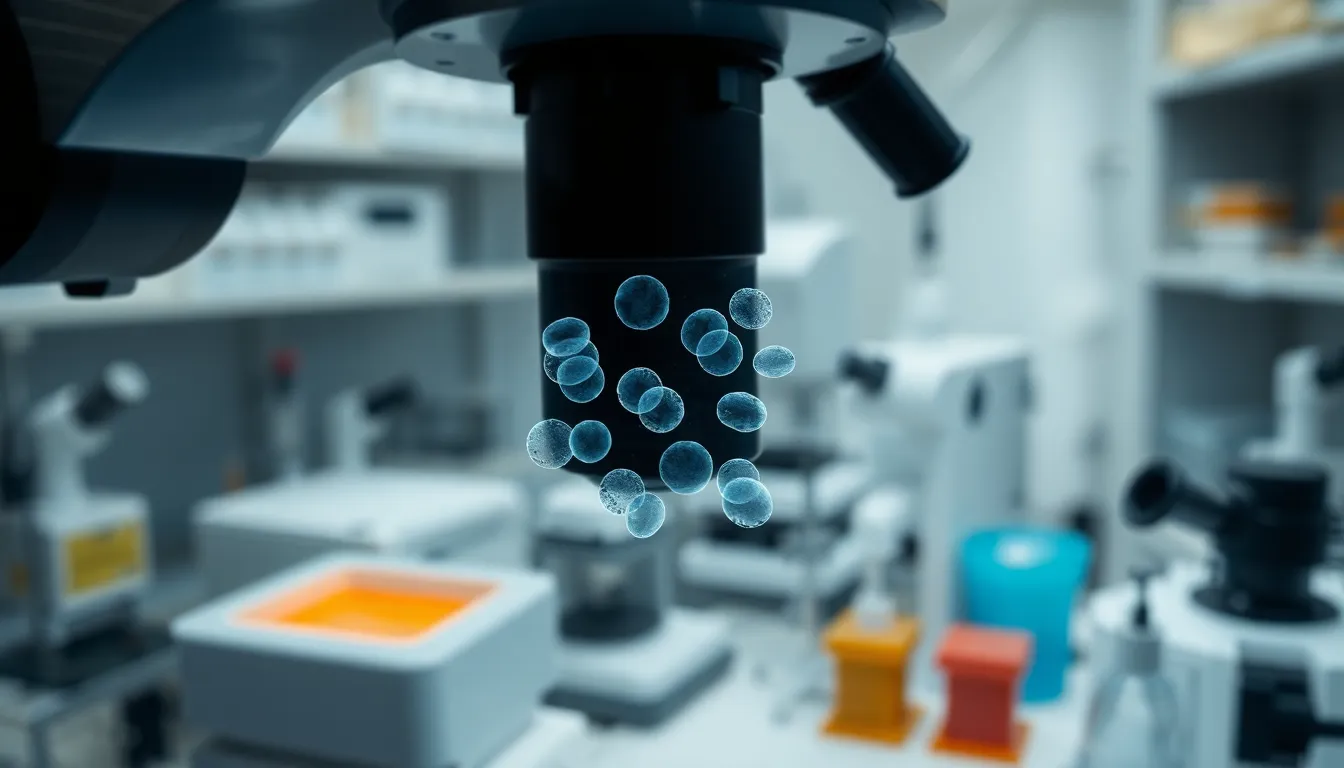Stem cells hold incredible potential in the realm of medicine, often referred to as the body’s raw materials. These unique cells can develop into various types of cells, making them invaluable for research and treatment. Their ability to regenerate and repair damaged tissues positions them at the forefront of innovative therapies.
In recent years, interest in stem cells has surged, as they offer hope for conditions ranging from spinal cord injuries to degenerative diseases. Understanding what stem cells are and how they function is crucial for grasping their role in modern medicine. This exploration delves into the diverse applications of stem cells and their significance in advancing healthcare solutions.
Table of Contents
ToggleWhat Are Stem Cells?
Stem cells serve as the body’s fundamental building blocks. They possess the unique ability to differentiate into various specialized cell types, including muscle, nerve, and blood cells. Two primary types of stem cells exist: embryonic stem cells and adult stem cells.
- Embryonic Stem Cells: Acquired from early-stage embryos, these cells can develop into any cell type in the body, offering extensive potential for regenerative medicine.
- Adult Stem Cells: Found in tissues like bone marrow and blood, these cells maintain and repair the specific tissues where they reside. Their differentiation capability is typically limited to cell types related to their origin.
Stem cells play a crucial role in scientific research. They provide insights into developmental processes, disease mechanisms, and potential therapies. Researchers utilize stem cells to study conditions such as cancer, genetic disorders, and autoimmune diseases. Their application in clinical settings includes treatment for blood disorders and certain cancers through bone marrow transplants.
The ongoing exploration of stem cell therapy signals a transformative shift in medical treatments. Increased understanding of stem cell biology enhances prospects for developing innovative therapies, potentially revolutionizing approaches to complex health issues.
Types of Stem Cells

Stem cells are categorized into several types based on their origin and potential. Understanding these types is crucial for appreciating their applications in medical research and therapy.
Embryonic Stem Cells
Embryonic stem cells (ESCs) originate from early-stage embryos. They exhibit pluripotency, allowing them to differentiate into any cell type in the body. Their extensive potential makes them valuable for regenerative medicine, particularly in developing treatments for conditions such as diabetes, Parkinson’s disease, and spinal cord injuries. ESCs also contribute significantly to research, helping scientists understand early human development and various genetic disorders.
Adult Stem Cells
Adult stem cells, also known as somatic stem cells, are found in specific tissues throughout the body, such as bone marrow, fat, and blood. Unlike embryonic stem cells, they have a more limited differentiation potential, typically developing into the cell types of their tissue of origin. Adult stem cells play a vital role in maintaining and repairing tissues and are integral in treating conditions like blood disorders, certain cancers, and injuries. Hematopoietic stem cells, sourced from bone marrow, are used in therapies such as bone marrow transplants to treat leukemia and other blood-related diseases.
Applications of Stem Cells
Stem cells serve various essential functions in medicine and research, showcasing their transformative potential. Their applications span medical treatments and research and development, each contributing to advancements in healthcare.
Medical Treatments
Medical treatments utilizing stem cells focus on regenerative capabilities. Hematopoietic stem cells play a significant role in treating blood disorders. They facilitate bone marrow transplants for leukemia and certain cancers, restoring healthy blood cell production. Mesenchymal stem cells, derived from bone marrow or fat tissue, aid in treating conditions like osteoarthritis and heart disease by promoting tissue repair. Clinical trials are investigating stem cell therapies for neurodegenerative diseases, such as Alzheimer’s and multiple sclerosis, highlighting their potential to regenerate damaged tissues and restore function.
Research and Development
Research and development involving stem cells contribute profoundly to understanding disease mechanisms. Scientists utilize embryonic stem cells to explore human development and genetic disorders. This research aids in identifying potential treatment strategies for conditions like spinal cord injuries and congenital diseases. Adult stem cell studies focus on tissue regeneration and repair, enhancing knowledge of tissue-specific stem cell behavior. Ongoing advancements in stem cell technology facilitate the development of personalized medicine, improving treatment outcomes by tailoring therapies to individual patient needs.
Benefits of Stem Cell Therapy
Stem cell therapy offers diverse benefits across various medical fields, enhancing treatment options and improving patient outcomes.
- Regeneration of Tissues: Stem cells promote the regeneration of damaged tissues, accelerating recovery in conditions such as heart disease and osteoarthritis. Mesenchymal stem cells trigger repair processes, enhancing healing.
- Treatment of Blood Disorders: Hematopoietic stem cells play a critical role in treating blood disorders. They facilitate bone marrow transplants that restore healthy blood cell production in patients with leukemia and other blood-related diseases.
- Potential for Neurodegenerative Diseases: Stem cell therapies demonstrate potential in treating neurodegenerative diseases. Research targets conditions like Alzheimer’s and multiple sclerosis, aiming to regenerate damaged neural tissues and restore function.
- Understanding Disease Mechanisms: Stem cells serve as valuable tools in research, helping scientists understand disease mechanisms. By studying embryonic stem cells, researchers identify genetic disorders and develop potential treatment strategies.
- Personalized Medicine: Ongoing advancements in stem cell technology contribute to personalized medicine. Tailoring therapies based on individual patient needs improves treatment efficacy, enhancing overall healthcare.
- Pain Relief: Stem cell therapies offer significant pain relief for conditions like osteoarthritis and chronic pain syndromes. They reduce inflammation and promote healing, leading to enhanced quality of life.
- Reduced Risk of Rejection: Autologous stem cell transplants—using a patient’s own cells—minimize the risk of rejection. This approach enhances safety and efficacy compared to traditional grafts.
Stem cell therapy’s versatility continues to expand in medical applications, underscoring its significant potential to shape future healthcare solutions.
Challenges and Ethical Considerations
Exploration of stem cell research faces significant challenges and ethical considerations. Regulatory frameworks often dictate the guidelines for stem cell research. Each country has different regulations, leading to discrepancies in research capabilities and available therapies. Adherence to these frameworks ensures ethical transparency but may also hinder rapid advancements in stem cell applications.
Debates about the ethical implications of using embryonic stem cells continue. Harvesting these cells typically occurs at the blastocyst stage of embryonic development, raising concerns among various groups. Individuals opposed to this practice cite potential moral issues related to the status of the embryo, complicating public and political discussions surrounding funding and research initiatives.
Concerns about informed consent are paramount in stem cell research. Researchers must ensure that donors understand the risks and benefits associated with donating cells. This is particularly crucial when dealing with vulnerable populations, such as those with limited health literacy. Clear communication fosters trust and upholds ethical research practices.
Potential exploitation of stem cell therapies is another challenge in this field. Some commercial entities may promote unverified treatments, misleading patients about their effectiveness and safety. Vigilance across the medical community is required to protect patients from unscrupulous practices while promoting legitimate research advancements.
Societal acceptance of stem cell technologies plays a crucial role in their development. Public perceptions can influence funding, policy-making, and the direction of research. Education and outreach are vital for improving understanding and acceptance of stem cell therapies, ultimately ensuring broader support for ethical research and clinical applications.
The potential of stem cells in medicine is vast and continues to grow. Their ability to transform into various cell types opens doors for innovative treatments and therapies. As research advances, the promise of stem cells in addressing complex health issues becomes increasingly evident.
While challenges and ethical considerations remain, ongoing exploration in this field is crucial. Understanding both embryonic and adult stem cells enhances their applications in regenerative medicine and research. With continued education and societal support, stem cell technologies could revolutionize healthcare and improve the quality of life for countless individuals.



